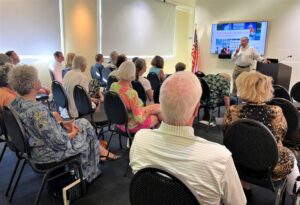On August 31, Coronado Historical Association (CHA) President Dave Landon introduced what he called a pop-up forum to separate fact from fiction regarding the Orange Avenue Corridor Specific Plan. The meeting was prompted by the recently proposed changes for the La Avenida building on the corner of Orange and B Avenues. Landon gave examples of historic buildings that have been changed, like in the 1300 block of Orange Avenue, the Reid Hotel, which is now Bank of America, and the Police Department, which was formerly Babcock Court.
In 2003, the city committed $300,000 to the Orange Avenue Corridor Specific Plan project to “provide a policy and regulatory bridge between the city of Coronado General Plan and individual, project-level development.” The city council approved the plan in 2004 after multiple community workshops and citizen involvement, and has made minor amendments to the plan through 2014.
The original committee was comprised of 12 members: Chair and City Councilmember Phil Monroe, Mayor Tom Smisek, Planning Commissioners Dani Heron and Guy Zeller, Design Review Commissioner Doug St. Denis, Chris Ackerman from Coronado MainStreet, Liz Forsyth-Lovell from the Coronado Chamber of Commerce, property owner Linn Kovar, business owners Scott Grimes, John Ovrom, and Eddie Warner, and former chair Mona Wilson. They worked with the following consultants: Principal Mirk Brodeur from the RRM Design Group, Associate Danielle Putnam of RFB Consulting, Principal Alan Hoffman of The Mission Group, and Principal Gerald Trimble, of Keyser, Marston & Associates.
“The purpose of the design criteria is to protect the special identity of the commercial areas of Coronado,” in particular, the special “village” character. The original chairman Phil Monroe passionately highlighted that the plan was created to:
- Preserve and enhance downtown Coronado.
- Prevent the “canyonization” of Orange Avenue.
- Don’t let Coronado become “Generica USA.”
- Don’t let what happened to La Jolla happen to Coronado.
Monroe gave the Third Street Promenade in Santa Monica as an example of a California city specific plan, and the city hired consultants who had experience with creating these types of plans. He emphasized that the number one rule of the committee was “no voting on issue to move forward, but rather continued dialogue until a consensus was reached, which created more buy-in from the members.” He commented that the specific plan is a regulatory document, which should be followed. It was suggested that the Planning Commission needs to show that decisions are based on the plan, and someone should be designated as the formal authority to enforce decisions. He said that the plan has lots of definites but allows for wiggle room through special use permits. Monroe said that he recently had a productive meeting with City Manager Tina Friend who has reviewed the plan, and he will bring these suggestions back to her.
Some of the details outlined in the plan include a 32-foot, two-story, building height limit, unified signage and wayfinding, suggested types of businesses, parking issues, design and landscaping criteria, and more. The following buildings were designated as role model buildings: the La Avenida Complex and the Brigantine restaurant, El Cordova Complex, Coronado Brewing Company, Spreckels Building, Baywalk Neighborhood Shops, Glorietta Bay Inn, and the Coronado Police Station. The detailed plan can be found at HERE.
Original committee member and architect Chris Ackerman said he was impressed at how much was accomplished in the plan but suggested more needs to be done. He pointed out that after 20 years this is still a good basis, but there are things that could be brought up to date. For example, the plan excludes grocery stores larger than 5,000 square feet, which is inconsistent with the new Vons expansion, but everyone agrees that this is a much needed upgrade. Monroe mentioned that major updates to the document would trigger a Coastal Commission review and said, “we’d lose more than we would gain in that process.”
CHA board member Clyde Van Arsdall asked for examples of how the plan has worked over the years and was told that the CHA building is designated historic, there are no three-story buildings, and Landon mentioned that David Spatafore maintained the tower at the request of the Design Review Commission for his Stake expansion on the second story of the La Avenida complex. Monroe praised Councilmembers Marvin Heinze and Mike Donovan, who were in the audience, for getting the Blanco Restaurant proposal in the La Avenida complex back on the agenda for the September 6 city council meeting, so residents can give their input.





